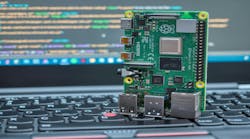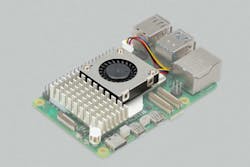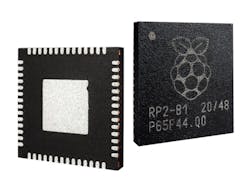Pi Day: What's the State of Raspberry Pi in 2024?
This article is part of the TechXchange: Raspberry Pi.
What you’ll learn:
- Insight into the latest Raspberry Pi technologies.
- Potential applications for Pi.
Every year on March 14, tech enthusiasts around the world come together to celebrate Raspberry Pi Day, an unofficial holiday honoring the groundbreaking single-board computer (SBC) that’s revolutionized DIY projects and more. (Yes, also to celebrate the number.)
Since its launch in 2012, the Pi has captured the imagination of engineers, makers, and educators alike, empowering them to explore computing in new and innovative ways. From simple projects such as retro arcade machines and home automation to complex applications in robotics and machine learning, the versatility and affordability of the Pi have made it a staple of classrooms, workshops, and industries worldwide.
As we commemorate Raspberry Pi Day (3.14), let’s look at some of the latest tech the RPi Foundation has to offer.
Raspberry Pi 5 for Those Who Missed It
The Raspberry Pi 5 (Fig. 1) is the latest iteration of the popular SBC that launched back in September of 2023, four years after the success of the RPi 4. A lot can change in four years, and that notion isn’t lost with the latest board, which managed to deliver over double the performance of its predecessor.
It’s also the first board to feature silicon designed in-house, and the first to come outfitted with the new BCM2712 SoC. The SoC packs an Arm Cortex-A76 quad-core processor (with crypto extensions), 512 kB per-core L2 caches, 2-MB shared L3 cache, and a VideoCore VII GPU.
That GPU can drive two 4Kp60 HDMI displays, up from a single 4Kp60 or dual 4Kp30 on the Pi 4. To keep the system supplied with memory bandwidth, the Foundation equipped the board with a 32-bit LPDDR4X SDRAM subsystem, running at 4267 Mtransfers/s, up from 2000 Mtransfers/s on Raspberry Pi 4.
Furthermore, the Raspberry Pi 5 comes equipped with an RP1 I/O controller, which offers a pair of USB 3.0 and USB 2.0 interfaces; a Gigabit Ethernet controller; two four-lane MIPI transceivers for camera and display; analog video output; and a 3.3-V general-purpose I/O (GPIO) with the same familiar pinout.
On top of that, the Pi 5 incorporates a Renesas DA9091 “Gilmour” power-management IC (PMIC) that integrates eight separate switch-mode power supplies to generate various voltages for the board and add-on modules. This includes a quad-phase core supply that’s capable of providing 20 A of current to power the CPU and other digital logic devices in BCM2712.
To complement the board, software engineers created a new version of the Raspberry Pi operating system based on Debian code-named Bookworm, which replaces Raspbian. It also uses the latest version of Python, changing the way modules are installed, which is done via the PEP 688 API for the buffer protocol. This minimizes the chance of a user installing a Python module that interferes with the version of Python installed for the OS.
A Closer Look at the RP2040
The RP2040 (Fig. 2) microcontroller made its debut in January 2021 in the form of the Raspberry Pi Pico microcontroller board, a versatile development platform with a smaller footprint than the Raspberry Pi. The chip’s numbering scheme denotes the hardware packed into the chip, with the RP standing for “Raspberry Pi,” the “2” representing the number of CPU cores, and the “4 and 0” representing the SRAM and non-volatile storage capacity.
Beyond the pair of Cortex M0+ cores and 264 kB of embedded SRAM, the chip packs 30 multifunction GPIOs (with six dedicated to SPI Flash), programmable IOs (PIOs), a 4-channel ADC with temperature sensor, and USB 1.1.
Unlike the Pico board, the RP2040 chips come without flash memory to store software and applications. As a result, an off-chip SPI must be interfaced to the MCU, enabling users to add as much storage (up to 16 MB) depending on requirements. The chip also allows users to design custom PCBs, making the RP2040 a versatile chip for any number of projects that go beyond the myriad Pico clones in different form factors.
Having two PIO programmable state machines offloads repetitive tasks from the cores, creates a more efficient chip, and opens up a world of creative PCB designs. So far, the RP2040 has been implemented in a multitude of board designs that include remote-monitoring platforms, robotics, IoT devices, home automation, and more.
Sneak Peek into What’s New to Come in 2024
On the heels of the Raspberry Pi 5 launch late last year (2023), Raspberry Pi CEO Eben Upton, while speaking at the Cambridge Raspberry Jam, hinted at potential new product releases. These included an RP2040 successor, which Upton stated, “We know what people don’t like about [RP]2040, the Arm Cortex-M0+ architecture could have more RAM, could have more GPIO. And we know what people do like, the PIO… and we have a chip team.”
Upton also stated that the Compute Module 5 will be launched this year (2024), offering a “high degree of commonality” with the Compute Module 4. Very little is known at this point, but it’s rumored that the CM5 will likely have the same dual connectors as the CM4 and a similar 55- × 40-mm form factor. This would be welcome news for manufacturers looking to upgrade their systems with a more efficient and powerful version of the module, especially when the world is still at the tail end of the global chip shortage.
Reflecting on the Evolution of Raspberry Pi
As we celebrate Raspberry Pi Day, we can reflect on the innovative advances made in the world of SBCs. The introduction of the Raspberry Pi 5, with its enhanced performance and features, marks a significant milestone for The Foundation and the evolution of its popular development board.
With double the performance of its predecessor, the RPi 5 boasts unparalleled efficiency and versatility using the latest Broadcom SoC. It was also the first I/O controller to be designed in-house, a first for the Foundation.
What’s more, the introduction of the RP2040 chip has opened up new avenues for creativity, empowering developers to explore a multitude of projects using custom-designed PCBs. The possibility of releasing a successor this year, along with the Compute Module 5, has engineers and makers looking at the possibilities the pair could bring in the coming months, adding the ice cream to the Pi celebration.
Pi Day fun fact: Albert Einstein was born March 14th - 1879!
And now a signout with some Pi fun to punctuate the celebration:
Read more articles in the TechXchange: Raspberry Pi.



